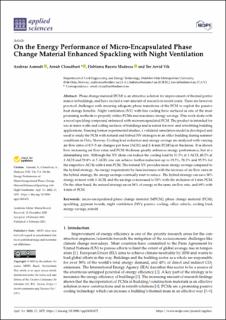On the Energy Performance of Micro-Encapsulated Phase Change Material Enhanced Spackling with Night Ventilation
Peer reviewed, Journal article
Published version
Permanent lenke
https://hdl.handle.net/11250/2756711Utgivelsesdato
2021-02-06Metadata
Vis full innførselSamlinger
Sammendrag
Phasechangematerial(PCM)isanattractivesolutionforimprovementofthermalperfor- mance in buildings, and have excited a vast amount of research in recent years. There are however practical challenges with ensuring adequate phase transitions of the PCM to exploit the passive heat storage benefits. Night ventilation (NV) with free cooling have surfaced as one of the most promising methods to properly utilize PCMs and maximize energy savings. This work deals with a novel spackling compound enhanced with microencapsulated PCM. The product is intended for use at inner walls and ceiling surfaces of buildings and is suited for new and retrofitting building applications. Ensuing former experimental studies, a validated simulation model is developed and used to study the PCM with natural and hybrid NV strategies in an office building during summer conditions in Oslo, Norway. Cooling load reduction and energy savings are analyzed with varying air flow rates of 0.5–5 air changes per hour (ACH) and 2–4 mm PCM layer thickness. It is shown how increasing air flow rates and PCM thickness greatly enhances energy performance, but at a diminishing rate. Although the NV alone can reduce the cooling load by 11.5% at 1 ACH, 40.2% at 3 ACH and 59.8% at 5 ACH, one can achieve further reduction up to 19.5%, 78.2% and 95.5% for the respective ACHs with 4 mm PCM. The natural NV provides more energy savings compared to the hybrid strategy. As energy requirement by fans increases with the increase of air flow rates in the hybrid strategy, the energy savings eventually start to reduce. The hybrid strategy can save 38% energy at most with 3 ACH, and the savings is increased to 50% with the inclusion of 4 mm PCM. On the other hand, the natural strategy saves 56% of energy at the same air flow rate, and 69% with 4mmofPCM.

